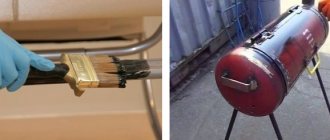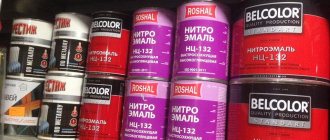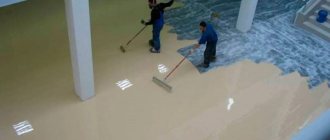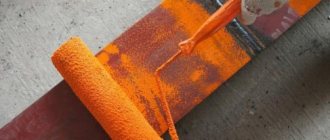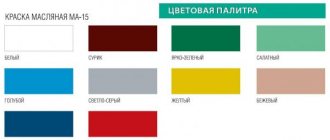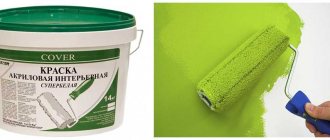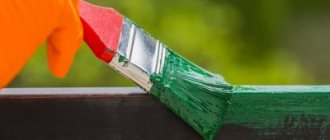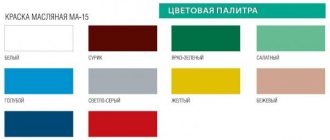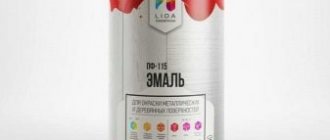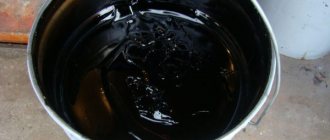NTs-132 enamel belongs to the class of alkyd enamels and is a suspension of pigments with nitrocellulose in a solution of colloxylin and alkyd resin in a mixture of plasticizers and organic solvents. NTs-132 is used for painting wooden and pre-primed metal surfaces exposed to atmospheric conditions. Depending on the application method, two types of enamel are produced:
- NTs-132 “P” - for spraying has a liquid consistency.
- NTs-132 “K” - for application with a brush, thicker.
At the same time, NC-132 enamel with the “P” index can be applied with a brush, and with the “K” index, when diluted with a solvent, it can be applied by pneumatic spraying.
Material composition
Paint grade NTs-132 is produced in accordance with GOST 6631-74. The product is often called nitroenamel, because it contains a nitrocellulose component.
The composition of the paint is represented by the following substances:
- colloxylin varnish;
- alkyd resin;
- plasticizers;
- pigments of different colors;
- special fillers.
The product is available in two forms - NTs-132K and NTs-132P. The composition of the components in the enamels is the same, the only difference is in the relative viscosity and dry residue. The distinction is necessary because enamel marked “K” is intended to be applied by brush, while enamel marked “P” must be applied by spraying. The product is produced in cans of 0.8, 1.5 kg, in industrial containers.
Warranty period and storage conditions
The enamel should be stored in tightly closed packaging, away from children; the temperature of the room where the enamel is stored should be no higher than +40 and lower than -40 degrees. There should be no flammable objects or heating devices nearby. Closed enamel has a shelf life of 1 year.
Enamel in small containers, no more than 2.7 kg. has a shelf life of 2 years.
The enamel should be stored in tightly closed packaging, away from children.
Properties
The material has a lot of useful properties. Very durable, resistant to friction, scratching, and other mechanical stress. The film created on the surface has excellent elasticity, so the paint can be used even on parts and products with large curvature.
Other material properties:
- the protective film provides resistance to the influence of water and household chemicals, detergents, oils; enamel can be applied in damp rooms;
- it is possible to grind and polish the coating without compromising quality - on the contrary, you get a decorative gloss;
- product consumption is low - the enamel is very economical and easy to use;
- the material is durable, provides quick drying and protects metal surfaces from corrosion;
- does not fade for a long time under the influence of ultraviolet radiation.
The enamel can be used in different temperature conditions: it can withstand temperature changes from -12 to +60 degrees. The variety of paint colors is amazing - the production of white, black, red, brown, yellow enamel, pistachio, green, blue and many others with various shades lighter and darker has been established.
Usage Segments
Technical indicators and properties of the composition allow the use of NTs-132:
- for indoor and outdoor work;
- wooden objects are covered. Fresh wood is protected by the composition in harsh climatic conditions;
- interaction with concrete, metal (the surface is pre-treated with a primer to enhance adhesion);
- products that are characterized by mechanical loads are protected;
- decorate surfaces in rooms of house buildings with high humidity;
- protection of metal in everyday life and at work from corrosion.
Characteristics
The technical characteristics of the material will depend on the type of paint (P or K), so below are the ranges of the main indicators and numbers common to both paints:
- drying time - 2 hours “touch-free” at +20 degrees, 24 hours until final drying;
- consumption - 30 - 120 g/sq.m. m depending on the type of application;
- the appearance of the coating is uniform, without inclusions, pits and bumps, wrinkles, and drips;
- hardness according to the TML device - 0.15 cu. e., according to the U-1 device - 50 cm;
- viscosity according to VZ-4 - 60 - 100 s;
- the proportion of dry residue for red enamel is 29 - 35%, for other colors - 32 - 40%;
- hardness according to the M-3 pendulum type device - 0.3 cu. e.;
- resistance to industrial oil at room temperature - 6 hours, to water - 1 hour;
- enamel solvent - No. 646.
Features of enamel NTs-132
- The temperature range in which the enamel coating can be used is from -12°C to +60°C.
- Drying time before sticking at a temperature of 21-25°C is 2 hours, until completely dry - 24 hours. At lower temperatures, drying time will be longer.
- The coating, consisting of a layer of appropriate primer and 2 layers of NTs-132 enamel, in temperate climates retains its stability and protective properties for at least 2 years.
- Available in colors: white, black, red, cream, greenish yellow, golden yellow, pistachio, light gray green, pale green, dark blue green, gray green, pistachio, light blue, gray blue, gray-blue, light gray (two types), light beige, red-brown, orange-brown, protective, tobacco, dark gray. At the customer's request, tinting according to the RAL catalog is possible.
Application order
Before painting, you need to carry out preparatory measures. Surfaces are cleaned of dirt, debris, dust, and oil stains. Existing rust needs to be removed.
Metal products are pre-primed using primers such as GF-020-021, FL-03K, GF-032.
You can dilute the dull-colored product with solvent 646 in a 5:1 ratio and use it as a primer. It is also advisable to prime wood, although this is not necessary, as when processing metal.
The base must be completely dry before painting. The paint should be thoroughly mixed, and the thickened film should be removed from above. How to dilute the material if the thickness is exceeded? You can use the same solvent 646.
Application is carried out depending on the type of paint using a brush or spray. After creating the first layer, wait 2.5 hours, then apply another layer. Polishing may only be done after final drying.
Safety precautions
Since nitroenamel NTs 132 is flammable and toxic, when working with it it is necessary to wear protective clothing, goggles and a respirator. Also, working near flammable objects and heating devices is not allowed.
If painting is carried out in a building, good ventilation must be ensured.
If painting is carried out in a building, good ventilation must be ensured.
This enamel has many advantages that make it popular. Low price and good properties together give enamel a great advantage over other similar products. If you follow all safety precautions when working with enamel, the painted surfaces will last a long time and have a beautiful appearance.
What affects the mass of paintwork materials - factors
The weight of any substance in kg can be converted to volume in liters, and the calculation can also be done in the reverse way. Such knowledge is often needed by buyers of construction and finishing materials, which is why many are interested in what the mass of a certain can of paint is. It is not always possible to find information on the Internet or reference books, because paint and varnish materials are not the same in composition and are produced by different manufacturers. Difficulties may arise when purchasing a non-standard container, and then the calculations have to be done manually.
How to save paint
Consumption is affected not only by those factors that are indicated directly on the paint packaging itself. There are additional factors to keep in mind.
- The density or hiding power of the paint, that is, how well the paint covers the color of the wall on which it lies.
- The higher the density, the lower the paint consumption.
- To calculate this indicator, you need to multiply the area of the wall that will be painted by the number of layers.
- Round the final number by increasing the number.
It is also worth considering how high-quality the surface is to be painted, what method the paint will be applied to, and how well the wall is prepared.
Sometimes two layers are not enough to paint a wall well and efficiently. In addition, you need to know that paint manufacturers indicate in the instructions the paint consumption for smooth, pre-prepared walls. To avoid unpleasant situations, after calculation it is worth adding a small percentage to the final number.
Basics of calculation
To calculate, you need to take pencils, a meter tape, a multiplication table or calculator and a piece of paper. And follow these steps:
- Measure the length of the walls to be painted using a meter tape. Then calculate the perimeter. For example, if the length is 5 meters and the width is 6 meters, then the perimeter will be 22 meters. 5+5+6+6 = 22 or (5*2)+(6*2)=22, or (5+6)*2=22 Formula for finding the perimeter: P=a+a+b+b=( a*2)+(b*2)=(a+b)*2;
- You need to measure the height to the ceiling or to the place where you want to paint the wall. For example, if the height is 2 meters, then the area will be 44 square meters. 22*2=44
Formula for finding area: S(area)=P(perimeter)*2;
- Calculate the height and width of doors and windows, their total perimeter and area;
- From the area of the room you need to subtract the area of doors and windows;
- The formulas for calculation are indicated on the paint packaging. It is necessary to use them and also take into account the quality of the surface.

